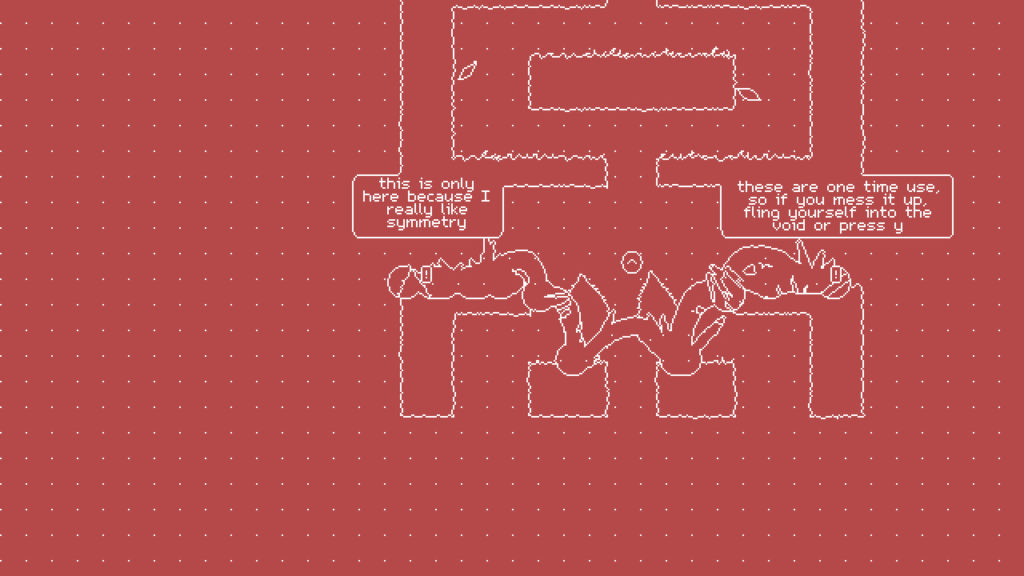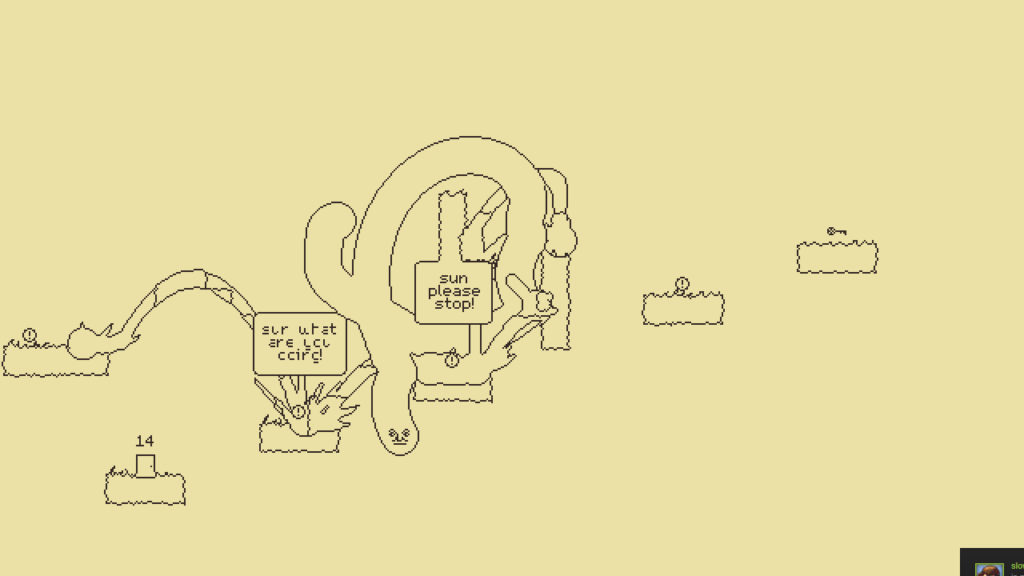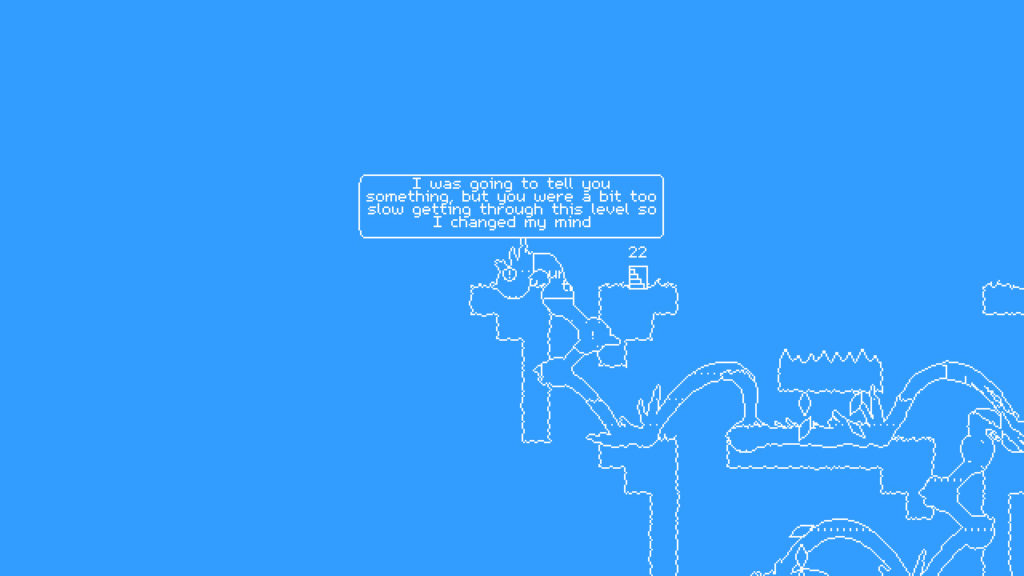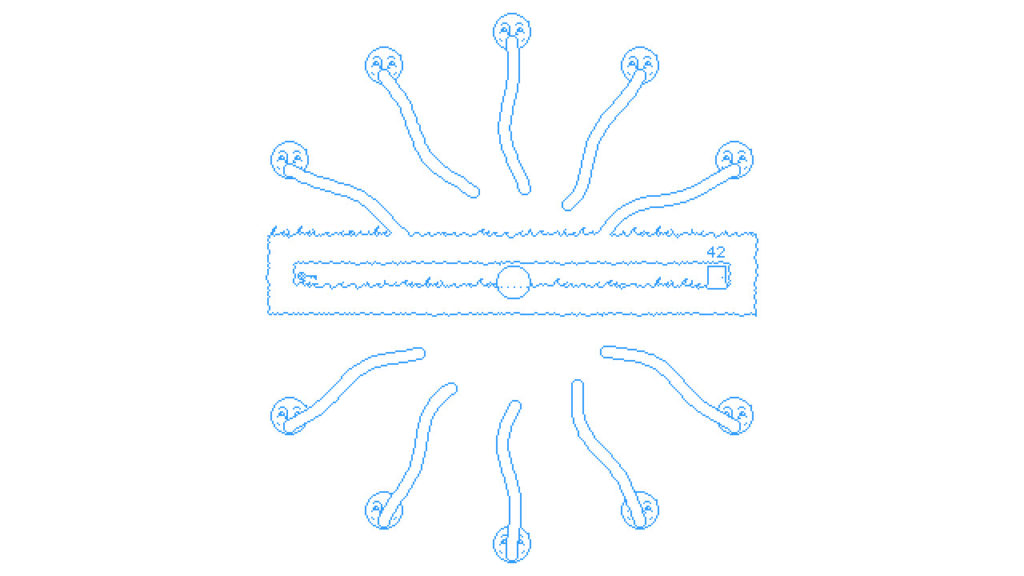Game Jolt Page || itch.io Page
Mistakes can often come back to haunt you when you’re a sentient outline. Outline is a platformer where your character is defined through an absence of space and everything it touches is erased from sight, which adds a new layer of challenge to the act of backtracking through levels while simultaneously creating a unique aesthetic identity.
This is a rather straightforward platformer with 50 fairly small levels and not much in the way of bells and whistles to incentivize replaying it so most players can see everything Outline has to offer within about two hours. That said, Outline makes the most of its duration with solid platforming, fun dialogue, and excellent usage of its unique take on scenery destruction. As a mere outline, you are only capable of jumping, grabbing ledges (somehow), and sliding down and jumping off of walls. Like the platforming itself, the goal of each level is kept simple – reach the exit and sometimes pick up a key along the way to unlock it. There’s no time limit to worry about, you die in one hit from anything, respawning is instantaneous, and every tenth level serves as a checkpoint which can be accessed from the hub. At its heart, this game really is a simple and solid platformer with consistently strong level design and a balanced difficulty curve, though it is also built so heavily around its aesthetics that the levels which feel so solid here would not work well elsewhere.

With its monochrome color scheme, the pencil writing noises you make as you move, and the giant splotches of erased space the protagonist makes whenever it lands after a long fall, Outline does its best to make you feel like you’re moving through a world made out of some rather unusual ink and paper. Rather than treating the protagonist as complete nothingness, it might make more sense to think of it as a living blob of invisible ink, one which specifically makes anything it touches invisible. From a purely aesthetic standpoint, this effect is spectacular because the world is layered; any part of a level which has been turned invisible by the protagonist serves as a window showing the level which came before it. Even the act of moving through the hub area gradually reveals the initial main menu screen. The effect is mesmerizing without being unpleasantly disorienting and it gives a sense of physical presence to the blank white backgrounds which would otherwise appear to be purely empty space.

On the gameplay side of things, your trail of invisibility leads to two significant repercussions taken into account by the level design. First, surfaces which you have passed over become invisible while still physically existing. Moving spikes and enemies aren’t affected by your trail, but constantly sticking too close to the ground or failing the same jump repeatedly without dying can make it difficult to tell where platforms begin and end or even where the border between the current level and the previous level lies. Secondly, your character blends in with its own trail, making it increasingly difficult to pinpoint your exact location if you move back and forth in the same area without pushing onward. As a result of these effects, paths through levels are rarely straight and often include a few red herring splits or crisscrossing intersections which become more difficult to navigate each time you pass through them. The locked exit door is also frequently placed at or near the start so players will have to travel to the other side of a level for a key and then make their way back. I normally dislike levels in games which force players to backtrack to the start after reaching the end because it usually feels like a lazy way of increasing the ‘challenge’ by requiring players to overcome every hazard twice in a single attempt, but it works well here because your original trails works against you; jumping around to dodge a hazard without making much progress or taking a slow and safe path while working your way towards a key will make the return trip significantly harder as you must recall ledges from memory and dodge those same hazards with a significantly less accurate idea of where your character is located.
![]()
My favorite part of Outline is its laid-back nature. This isn’t to say that this game is necessarily relaxing, the later levels are outright brutal, but the experience remains an enjoyable one rather than a frustrating one even when you’re repeatedly dying. The soundtrack plays a large role in establishing this tone as it remains persistently mellow and surreal even while the game is at its most sadistic. Floating exclamation points marking the locations of comments from the developer are also scattered across every level (whether this is meant to be the actual developer or a character in the role of the game’s developer isn’t clear and doesn’t matter). These notes are rarely useful, but they are almost inevitably amusing and usually fall somewhere along the lines of the developer congratulating himself on his own level design, taunting the player about how they are probably going to die to a hazard, or complaining about the player ruining their levels. There is an endearing sense of mildly antagonistic indifference to these messages which is made even better by the fact that many of them are located in out of the way locations which are harder to reach than the exits and sometimes require you to jump into a pit or land on a spike; the only reward for your effort is likely to be an insult or a complaint, but it’s far more amusing than words of praise or more tangible rewards would be. The levels themselves also embody this sense of playfulness as even though the overall difficulty steadily increases the level-to-level difficulty swings around unexpectedly; you will often make your way through two or three hard levels only to then find yourself in a level which is amusing without being particularly dangerous or a level which poses no danger at all, such as a maze with fake walls or a room full of bizarre insults.

Old elements are frequently reused in new ways to keep the gameplay from ever feeling too repetitive. Other than pits, the only hazards are technically spikes, moving diamonds, and some rather expressive suns, but each of these obstacles comes in multiple forms. Spikes are often stationary, yet later levels mix in moving spikes and, even more hazardous, spikes which pop in and out of the ground. Diamonds likewise are simple enemies which initially move between walls horizontally or vertically and eventually evolve to bounce off of walls at sharp angles. Suns are far more dangerous than diamonds and come in three distinct forms. Some stationary periodically shoot bullets at you and function like standard turrets while others release deadly continuous beams from their mouths, but the non-stationary suns will aggressively chase after you, picking up speed, bouncing off of walls, and leaving behind their own obscuring trails as they go. Aside from keys and hazards, there are also ‘boppers’, small circles with arrows in them which will be destroyed and send you flying in the direction which they are pointing. Boppers can be either mobile or stationary and, like everything else, they are put to use in multiple ways, sometimes serving as hazards designed to throw you into a pit or spikes and other times serving as fragile and volatile paths towards and exit door or a key; bopper paths leading to keys are particularly tricky because the fact that they don’t respawn means you need to make sure to leave enough on your way to a key to be able to make your way back to the exit. Even the developer messages are ultimately put to good use as four hidden messages are scattered throughout the game which reveal a code that is needed in order to access the final set of ten levels, which in turn are far more challenging than any of the previous levels.

Outline is a game which actively sets out to avoid having complicated mechanics or a deep story. Instead, it seeks to mimic a simple outline of a game by focusing entirely on being an entertaining little platforming adventure and it absolutely succeeds.